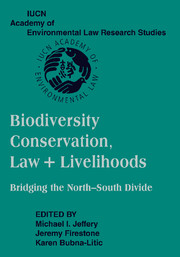 Biodiversity Conservation, Law and Livelihoods: Bridging the North-South Divide
Biodiversity Conservation, Law and Livelihoods: Bridging the North-South Divide Published online by Cambridge University Press: 31 July 2009
INTRODUCTION
With the expansion of global trade and international transport and tourism after China's integration into the world economy through the implementation of its open-door policy in the 1980s and the more recent accession to the World Trade Organization (WTO), China's biodiversity is becoming more and more threatened by the potential introduction of nonnative species. According to the very latest statistics from the Ministry of Agriculture, more than four hundred alien species have invaded China, at least twenty in the last ten years. Alien invasive species are found in all of the thirty-four provinces, autonomous regions, and municipalities under direct control of the central government. By May 2002, they had invaded almost all of the fifteen hundred nature reserves nationwide and all types of ecosystems, including forests, farmlands, inland waters, wetlands, grasslands, and urban residential areas. More than half of the world's worst alien invasive species published by the IUCN have invaded China.
The international community has become aware of the serious threat of alien invasive species to the ecosystem, biodiversity, human health, and socioeconomic well-being. Studies have found that the introduction of nonindigenous species is second only to direct habitat destruction in causing loss of biodiversity.
To save this book to your Kindle, first ensure [email protected] is added to your Approved Personal Document E-mail List under your Personal Document Settings on the Manage Your Content and Devices page of your Amazon account. Then enter the ‘name’ part of your Kindle email address below. Find out more about saving to your Kindle.
Note you can select to save to either the @free.kindle.com or @kindle.com variations. ‘@free.kindle.com’ emails are free but can only be saved to your device when it is connected to wi-fi. ‘@kindle.com’ emails can be delivered even when you are not connected to wi-fi, but note that service fees apply.
Find out more about the Kindle Personal Document Service.
To save content items to your account, please confirm that you agree to abide by our usage policies. If this is the first time you use this feature, you will be asked to authorise Cambridge Core to connect with your account. Find out more about saving content to Dropbox.
To save content items to your account, please confirm that you agree to abide by our usage policies. If this is the first time you use this feature, you will be asked to authorise Cambridge Core to connect with your account. Find out more about saving content to Google Drive.